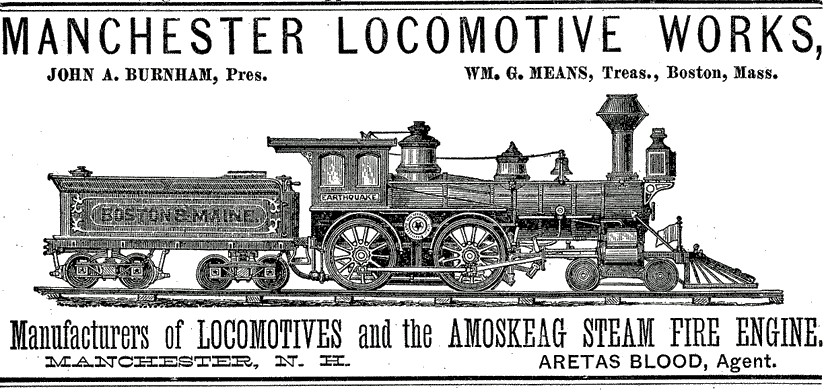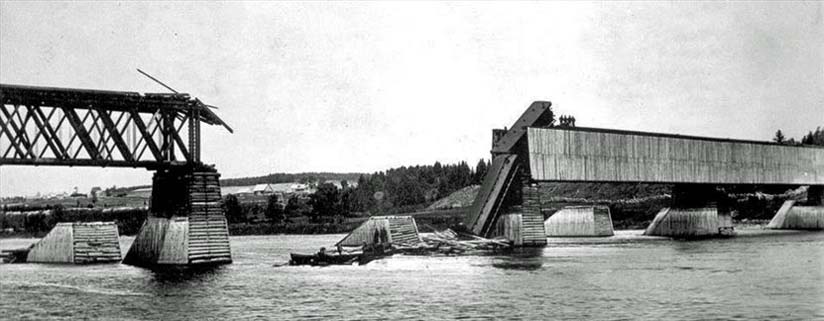
Grand Falls New Brunswick - COVID-19 has halted a lot of fun activities across Canada, but it may also have helped solve a great railway
mystery.
Whatever happened to Canadian Pacific Railway (CP) locomotive number 508 after it plunged into the St. John River?
That mystery has puzzled some residents of this New Brunswick town since a spectacular railway accident here on 21 Jun 1900.
Locomotive 508 was pulling a combination freight and passenger train from Edmundston to Fredericton across the wide St. John River when the wooden trestle
collapsed.

Most of the train plunged into the river, but the passenger car was at the end of the line and it landed on the rubble of the trestle with the freight
cars and stayed above the water.
There were many serious injuries, but miraculously no deaths.
The bridge debris and rail cars were pulled out of the river, but apparently, locomotive 508 was never found.
There are no photos or documents of its recovery.
Although the missing locomotive doesn't puzzle most residents of Grand Falls, it does Eric Ouellette, a 42-year-old structural engineer with Canadian
National Railway (CN).
He was a 21-year-old engineering student at the University of Moncton when he first learned about the trestle's collapse close to his Grand Falls home about
100 years earlier.
What intrigued him about the incident was the rumours that Locomotive 508 was never found.
That didn't sit well with his engineering brain.
How can a 35 ton steam locomotive simply disappear?
Ouellette's full-time job with CN is to check on the safety and condition of thousands of CN bridges and culverts in the Maritimes.
That includes keeping a close eye on CN's longest and highest railway trestle in Canada, which stretches 3,920 feet across the Salmon River 195 feet
below.
And his part-time job is operating Zip Zag, a zip line that Ouellette designed and built across the gorge at Grand Falls, where the St. John River plunges into
a ragged canyon before flowing through town.
It's one of the province's most popular vacation stops, but COVID-19 has shut the operation down this summer.
That gives Ouellette more time for his other passion, searching for 508.
He believes the elusive engine is near Zip Zag, above the roaring falls.
On 4 Jul 2020 a multi-beam ground-penetrating radar device Ouellette was operating on the river above the falls may have stumbled upon locomotive
508.
While floating on the river's surface aboard a small self-propelled boat, the radar scanning device detected about eight to 10 tons of metal under a large pile
of silt and sand sediment on the river bottom.
Ouellette says 508 weighed about 35 tons, but parts of the locomotive would have fallen off from the plunge into the river.
"The cow catcher at the front and the front wheels were never really attached to the locomotive. It was just the weight of the boiler that kept the front
axle attached. They would have separated with the plunge into the river. The same with the big smoke stack. Most of 508's weight comes from its two big drive
wheels on either side, the steam pistons that drive the wheels, and the mechanism that connects the drive to the boiler. The cab was made of wood and has
likely disintegrated," Ouellette said.
The river is much deeper today than it was in 1900 because a power station and dam was constructed in the 1920s just above the waterfall and created a small
lake.
Ouellette says a construction vacuum system could suck away much of the sedimentary deposit to reveal what metal is hidden there.
If it is 508, and he can get it to the surface, Ouellette would like to see it on display at the nearby abandoned CP station that was waiting for that train to
arrive in 1900.
Railway debris from the accident he recovered from the river in 2003 was donated to Du Reel au Miniature, a railway interpretation centre in Edmundston created
by Guy LaForge.
It has a large selection of miniature railways, plus a one-eighth-size railway that can carry up to 6,000 pounds on a 10 minute loop through a
forest.
Pat Brennan.
(because there was no image with original article) *2. Original news article image replaced.
(usually because it's been seen before)
provisions in Section 29 of the Canadian
Copyright Modernization Act.
